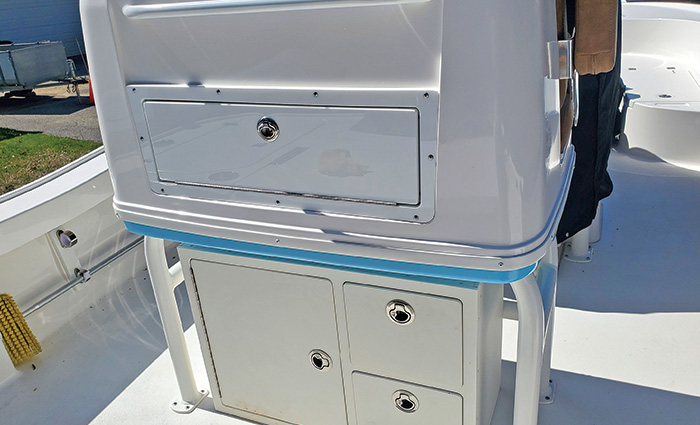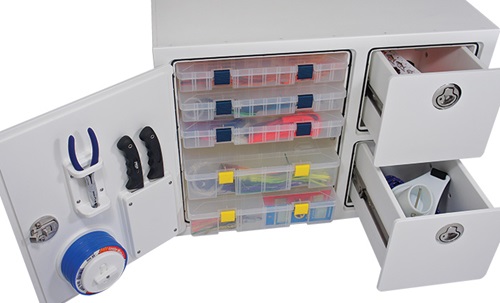Advertisement
Few boats come with onboard tackle stowage that’s sufficient for serious anglers – a problem easily fixed

The Boat Outfitters Free Standing Leaning Post Tackle Unit installed under the leaning post in place of a cooler on a Caymas 26HB. Photo: Lenny Rudow
Difficulty:
- Easy
Tools:
- Power drill and bits
- Screwdriver and/or socket wrench
- Jigsaw and blades
- Grease pencil
Materials:
- Tackle station or box
- Stainless mounting screws and/or through-bolts, washers, and nyloc locking nuts
- 3M 5200 adhesive/sealant
Time:
- +/- 1 hour
Cost:
- $1,000—$2,000
Anglers love tackle – lots and lots of tackle. And while most fishing boats come with some level of onboard tackle stowage, it’s rare to find one with enough to satisfy all your needs. A few small tackle trays simply won’t cut it, especially for multispecies anglers who might be fishing for tripletail one day and tuna the next. And who wants to lug a heavy tacklebox back and forth every trip? Nobody.
The good news is that adding onboard tackle storage to your boat can be easily accomplished in most cases. The bad news is that it won’t come cheap. Add-on tackle stations can cost hundreds or even thousands of dollars. Still, we say it’s well worth the expense to eliminate that carry-on tacklebox from the mix and have all your topwater baits, trolling lures, bottom fishing gear, jigs, and terminal tackle aboard, neatly stowed, and readily accessible. Here’s how.
1. Identify where you can add tackle stowage.
On the average 20-something-foot center-console, the most common place to add a tackle station is under a pipework-supported leaning post. Sometimes this area will be left open by the manufacturer, or it may have a cooler you’ll want to move out of the way. If there’s a large gap between the underside of the leaning post and a cooler, you may be able to mount a shallow-depth tackle station to the underside of the post and leave the cooler in place.
If your boat doesn’t have a pipework leaning post you may be able to find a place where there’s space to add a flush-mount tackle stowage compartment. This will take a bit more work, and you need to be able to inspect the area behind the surface where you’ll mount it to measure for sufficient space and ensure there aren’t any wires or plumbing in the way. Areas you may find space for such an installation include the sides or front of the console, fiberglass leaning posts, and other flat surfaces with “dead space” behind them.
Measure the dimensions of the open area to determine the size of the tackle station it can accommodate. On larger boats, you can also consider adding a freestanding unit in the cockpit, but this comes at the cost of open deck space.
2. In the case of a freestanding unit, use the grease pencil and the manufacturer’s supplied mounting template to mark the mounting points for drilling.
If the unit didn’t come with a mounting template, make one from paper or cardboard, or put the unit into position to mark the mounting holes.
Caution: When drilling into the deck under a leaning post or similar accessory, be aware there could be a fuel tank or other critical component located underneath. Never drill without first looking at the area underneath the deck. In most cases a deck access plate located in the cockpit sole (commonly positioned over the fuel tank for accessing its fittings) will allow for a visual inspection.
In the case of a flush-mount tacklebox, use the manufacturer’s supplied mounting template to mark the area to be cut out. Again, carefully inspect the area behind the cutout so you don’t accidentally saw or drill through anything important, and premeasure the area to be sure the tacklebox enclosure will fit.

With the holes drilled, it’s just a matter of driving the mounting screws (you’ll have to remove all the tackleboxes first) and adding a dab of 3M 5200. Photo: Boat Outfitters/Teak Isle

The most common option on an average center-console will be to mount a freestanding unit under the leaning post. Photo: Boat Outfitters/Teak Isle
3. Drill the mounting holes.
In the case of flush-mounting a unit, drill a pilot hole for the saw blade, then use the jigsaw to cut out fiberglass. Then drill the mounting holes.
4. Mount the unit using the fasteners, and seal the mounting holes with 3M 5200.
If it’s possible to access the underside or back of the mounting surface, opt for stainless thru-bolts, washers, and nyloc locking nuts as opposed to screws, because they’re more secure. In the case of a large freestanding unit added to an open area of the cockpit where people may lean against or sit on the tackle station, mounting with thru-bolts, washers, and nyloc locking nuts should be considered mandatory. If the beefiness of the deck is at all in question, backing plates may also be necessary.
